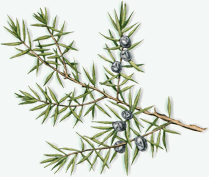 |
Search the site:

|
Juniper Juniperus communis Aiteal Native (Evergreen) (flowers in May) Male and female flowers occur in cones but grow on separate trees. The male cones are small and rather inconspicuous. The female cones also begin very small but swell to form green berry-like fruits that turn blue-black on ripening, eventually reaching a size of six to nine millimetres long. Although a wide range of exotic junipers are grown in gardens, in the wild it is not common except in rocky places, on mountains and lake shores in the west and north-west of Ireland, especially in Kerry Clare, Donegal and Connemara.
In the past its foliage was used for kindling. It has a fragrant smell when burnt. Juniper oil is an important constituent of gin and a peppery spice may be obtained from its seeds.
Blackberry, Bramble Blackberries are deciduous or semi-evergreen shrubs with prickly and woody scrambling stems. New shoots are produced from the base each year which lengthen and strengthen during their first year, then flower, fruit and die in their second year. After that the dead branches provide a useful skeleton through which the next year's shoots can grow, creating a dense and often impenetrable jungle. Like the shoots, blackberry leaves are prickly and are divided into three to five leaflets, very variable in shape and size. Their flowers are twenty to thirty millimetres broad, white or pink. The familiar fruits, made up of lots of separate fleshy segments each containing a single seed, change from green to red and finally ripen to purplish-black. Blackberry bushes occur abundantly in Ireland. They have the ability to produce seeds without having to be pollinated and so each bush is genetically isolated and any chance change in the genes can give rise to a new micro-species. Over 2,000 such micro-species have been named and described, making the group a nightmare for botanists.
© Copyright Ireland's Eye 1997 www.irelandseye.com |
[ Back to Top ]
All Material © 1999-2004 Irelandseye.com and contributors

 The
juniper can be either an upright or a prostrate bushy shrub. It has red-brown
flaking bark and short, stiff and prickly needle like leaves, one half to two
centimetres long, blue-green in colour, arranged in a whorl of three around
the shoot.
The
juniper can be either an upright or a prostrate bushy shrub. It has red-brown
flaking bark and short, stiff and prickly needle like leaves, one half to two
centimetres long, blue-green in colour, arranged in a whorl of three around
the shoot.
 Two
subspecies of the juniper occur in Ireland. Subsp. communis which can be either
upright or prostrate, with sharply pointed leaves, grows on limestone soils.
Subsp. alpina is always prostrate and has broader incurved, blunter leaves and
grows mainly on acid soils. It is commonest in Connemara.
Two
subspecies of the juniper occur in Ireland. Subsp. communis which can be either
upright or prostrate, with sharply pointed leaves, grows on limestone soils.
Subsp. alpina is always prostrate and has broader incurved, blunter leaves and
grows mainly on acid soils. It is commonest in Connemara.